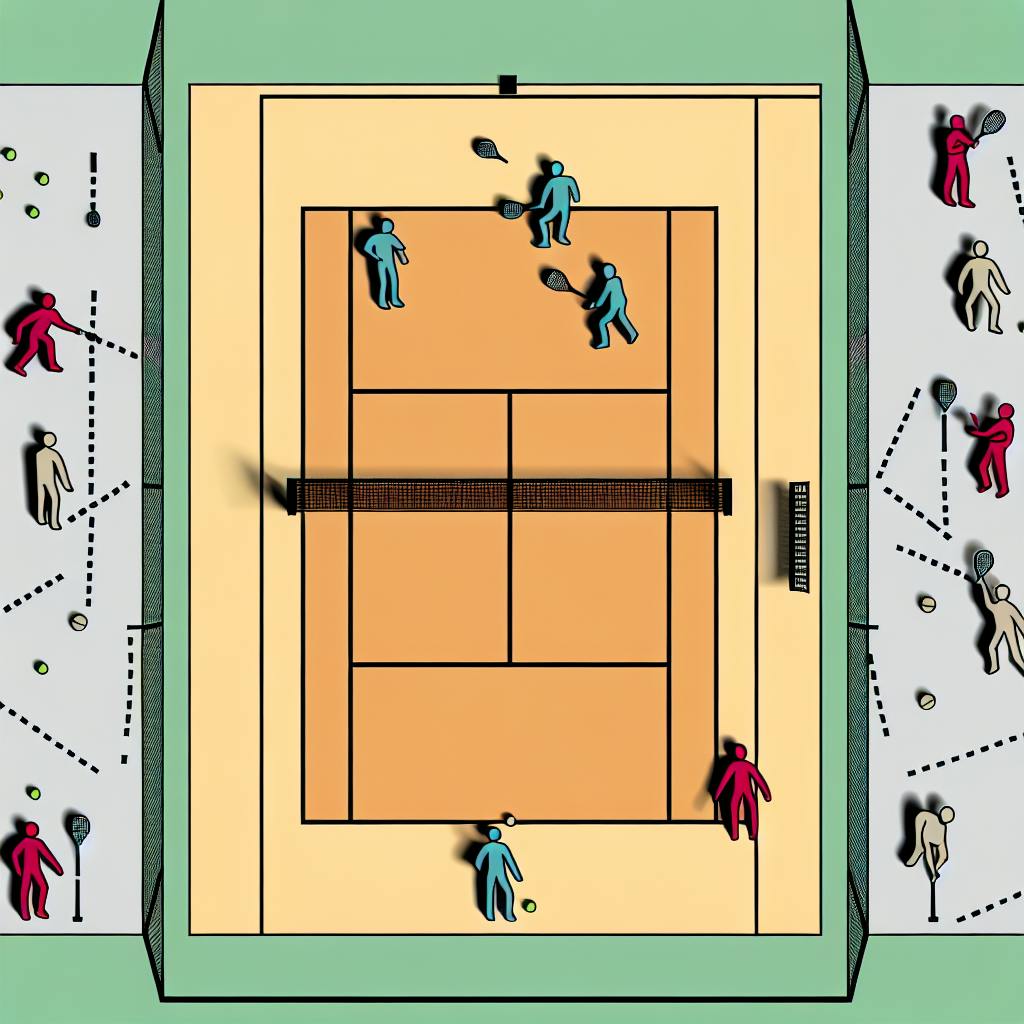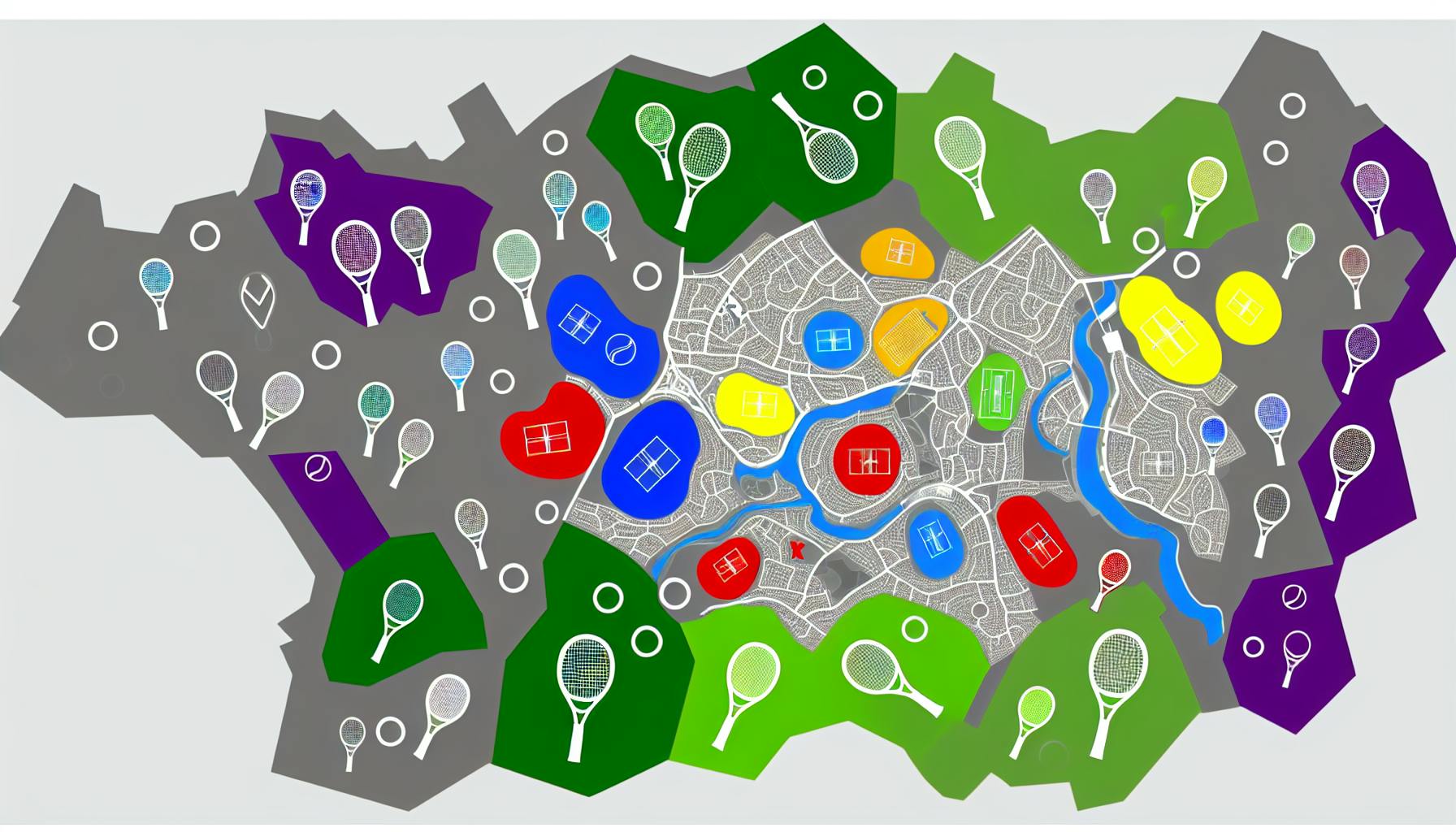Starting your journey in tennis involves mastering the basics through essential drills. Here's what every tennis beginner should focus on:
- Why Tennis Drills Matter: They improve movement, strategy, and make tennis moves feel natural.
- Key Focus Areas: Footwork, serving, forehand, backhand, and hand-eye coordination.
- Essential Drills: Practice forehand, backhand, and serving drills regularly to build your skills.
- Practice Frequency and Tips: Aim for 3-4 practice sessions each week, with each session lasting 30-45 minutes.
- Specialised Drills: Incorporate footwork, agility, and hand-eye coordination drills to enhance your game.
Remember, the key to improvement is consistent practice, focusing on technique, and gradually increasing the difficulty of your drills. With patience and perseverance, you'll start playing full games and serving aces in no time.
Why Tennis Drills Matter
Tennis drills are super important for beginners because they help you learn the right way to move and hit the ball. They're like practice exercises that make sure you're doing things correctly, so when it's game time, you can play without having to think about it too much. Drills are great for teaching you how to move quickly, hit the ball well, think about your next move, and stay strong throughout the game. They make sure you can play in different ways, depending on what the game throws at you.
Some reasons why drills are good include:
- Making sure your body remembers how to move and hit
- Helping you move faster and more smoothly
- Teaching you game strategies
- Keeping you mentally strong
- Making tennis moves feel natural
- Preparing you to handle different situations
Drills are a way to learn tennis step by step. They turn beginners into skilled players by repeating the basics until they're perfect.
Key Focus Areas for Beginners
For new players, it's all about getting the basics right. This means:
- Footwork: Being able to move well so you can hit your shots.
- Serving: Learning to serve well can give you an edge.
- Forehand: Getting good at forehand shots makes you confident.
- Backhand: A solid backhand keeps your game consistent.
- Hand-eye coordination: Being able to see the ball and hit it well is key.
Practising these skills over and over makes them automatic. This lets you think about your game plan instead of worrying about how to hit the ball. Once you've got the basics down, you can start learning more complicated moves.
Essential Drills for Beginners
When you're new to tennis, it's all about practising the basics to get better. Focus on the main strokes: the forehand, backhand, and serve. Doing drills over and over helps you learn the right way to play.
Forehand Drills
The forehand is a key shot in tennis. Here's a simple way to practice it:
- Stand ready with your feet apart and knees bent. Hold the racket with a semi-western grip.
- Have someone throw easy balls to your forehand side, or use a ball machine.
- Move a bit to get ready, and turn your upper body.
- Swing and hit the ball in front of you. Speed up your racket when you hit.
- Keep swinging towards where you want the ball to go.
- Keep practising to get better at moving, balancing, and hitting the ball right.
Try to hit 30-40 balls like this each time you practice to get good at it.
Backhand Drills
The backhand can be tricky for beginners. Here's a simple drill:
- Start ready, holding the racket with both hands.
- Get balls thrown or shot to your backhand side.
- Turn so your chest faces the net and get your racket ready early.
- Step into the ball and hit it in front of you. Swing smoothly.
- Swing your racket over your shoulder towards your target and pause there a bit.
- Focus on getting ready, moving right, and hitting the ball well.
Hitting 30-40 backhands each practice helps build this skill.
Serving Drills
The serve is super important because it starts the game. Here's an easy way to practice:
- Stand sideways at the back line. Hold your racket with a continental grip.
- Throw the ball up straight to the one o'clock spot.
- Pull your racket back and squat a little. Pause here.
- Jump up, stretch, and hit the ball high over the net.
- Swing fast where you hit the ball and follow through down.
- Practice getting a smooth flow, throwing the ball the same way each time, hitting it right, and speeding up your racket.
Do 10 serves at a time, aiming for 40-50 in each practice to get your serve right.
Practising these basic drills helps you learn the right way to hit forehands, backhands, and serves. Be patient, focus on doing each step well, and do lots of practice.
Drill Practice Frequency and Tips
Recommended Practice Schedule
If you're just starting with tennis, try to practice your drills 3-4 times a week. Each practice should last about 30-45 minutes. This helps you get better gradually and keeps you from getting too tired.
It's good to spread out your practice days, maybe every second day. This way, your body has time to rest, and you'll remember what you learned better than if you did everything at once.
During each practice, focus on practicing one or two types of shots. For example, work on your forehand one day, then practice your serve the next. This helps keep your practice balanced.
Adapting Drills for Progress
As you get better, you can make your drills harder in different ways:
- Try hitting more balls each time you practice a drill.
- Use ball machines to get a steady supply of balls.
- Practice doing the drills faster.
- Add in some movement challenges, like running to different spots between shots.
- Switch up who you practice with to get used to different styles.
- Stand further away from the ball to work on moving around more.
- Mix in some drills where you practice different shots one after the other.
It's also a good idea to sometimes take lessons or go to clinics. A coach can see if you're making any mistakes early on and suggest specific drills that are right for your level. This way, you can fix any problems before they become bad habits.
Most importantly, pay attention to how you feel. If something hurts or you're really tired, it's okay to take an extra day off. It's better to practice regularly without pushing yourself too hard. Change your practice plan based on how much energy you have and how quickly you recover.
sbb-itb-5591e69
Specialised Drills
Let's talk about some more focused drills that help with moving fast, being agile, and getting better at seeing and hitting the ball.
Footwork and Agility Drills
Moving well on the court is super important. Here are some drills to help you get quicker and more agile:
- Ladder drills - Use a ladder on the ground and practice different stepping patterns like stepping in and out of the ladder boxes, hopping, and moving sideways. This helps you move better in all directions.
- Cone drills - Place cones in patterns and run between them to practice quick turns and stops. Try moving in different ways like side steps or quick crossovers.
- Reaction drills - Have a friend point to a spot on the court, and then you run to it as fast as you can. Mix up the way you move with side shuffles or running backwards.
- Ball drops - Hold tennis balls and drop one randomly, then rush to pick it up. This is great for quick reflexes.
These drills make you faster and help you move around the court easily, so you can reach more balls during a game.
Hand-Eye Coordination Drills
Getting your eyes and racket to work together is key. Try these drills:
- Ball bouncing - Keep a tennis ball bouncing on your racket while moving around. This helps with watching the ball closely.
- Wall rallies - Hit the ball against a wall and keep the rally going. Move around to hit from different positions.
- Edge tapping - Use the edge of your racket to tap the ball gently and keep it in the air. Switch between forehand and backhand.
- Target practice - Set up targets on the court and try to hit them with your shots. It's like playing darts but with tennis balls!
Practising these drills will make it easier for you to hit the ball where you want it to go during matches.
By working on these specialized drills, you'll make the basic skills feel automatic, so you can focus more on your game plan and how you're positioning yourself on the court.
Conclusion
Let's finish up by saying that practising basic drills is super important when you're just starting with tennis. If you keep working on your forehand, backhand, serves, and footwork, these moves will soon feel like second nature.
Here's what you should remember:
- Start with easy drills to get your technique right.
- Aim to practice 3-4 times a week for about 30-45 minutes.
- As you get better, make the drills a bit harder.
- It's a good idea to take some lessons to help fix any mistakes early on.
- Keep yourself motivated by seeing how much you improve.
- Do drills that make your coordination better.
- Use cones and ladders to work on moving better.
- Hitting balls against a wall can help make your strokes more consistent.
- Always look for new challenges to improve.
Learning tennis is a journey that needs time and patience. But if you take it step by step and really nail the basics, you'll find yourself playing full games and serving aces sooner than you think! Keep a positive attitude, enjoy your practice, and you'll do great.


